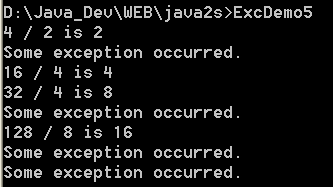Use the 'catch all' catch statement

/*
C#: The Complete Reference
by Herbert Schildt
Publisher: Osborne/McGraw-Hill (March 8, 2002)
ISBN: 0072134852
*/
// Use the "catch all" catch statement.
using System;
public class ExcDemo5 {
public static void Main() {
// Here, numer is longer than denom.
int[] numer = { 4, 8, 16, 32, 64, 128, 256, 512 };
int[] denom = { 2, 0, 4, 4, 0, 8 };
for(int i=0; i < numer.Length; i++) {
try {
Console.WriteLine(numer[i] + " / " +
denom[i] + " is " +
numer[i]/denom[i]);
}
catch {
Console.WriteLine("Some exception occurred.");
}
}
}
}
Related examples in the same category